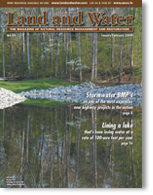Features Available Online
The Living Systems Approach:
Compost Based BMPs to Revitalize Disturbed Soils
by Rod Tyler & Nora Goldstein
IN 1999, several species of Puget Sound salmon were officially listed by the federal government as threatened under the Endangered Species Act. The Puget Sound region includes 12 counties and 18 watersheds from the Canadian border south to Olympia, Washington. A significant cause of the decline in the Puget Sound Chinook salmon and the bull trout was urbanization and the resulting surface water runoff that directly degraded the salmon habitat, especially their spawning grounds in the region's streams.
In response to the salmon becoming an endangered species as a result of stream and river degradation due to runoff, the Washington Organic Recycling Council (WORC) launched the Soils For Salmon campaign. At the heart of the campaign was the critical need to retain native soils and/or repair damaged soils, using compost and mulch, so that surface water from storm events could infiltrate the soil. Graphics were developed (Figures 1 and 2) to illustrate the dramatic reduction in surface water runoff — from 55 to 70 percent on a disturbed soil to 15 percent on an amended soil surface that mimics native soil.
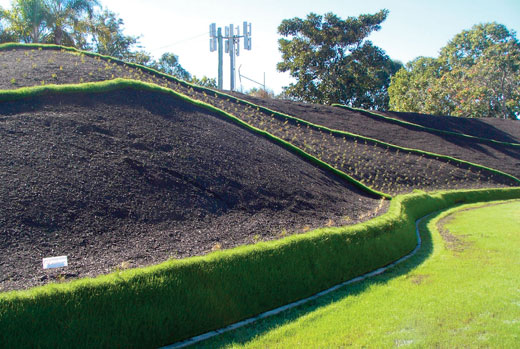
Compost based BMPs like these Filtrexx SiltSoxx have been used all over the world because compost is locally made, annually renewable,
bio-based, organic, recycled and natural. Photo credit: Integrated Landscaping, Australia.
The Soils for Salmon initiative is among several "watershed" events in advancing the use of compost and other recycled organic wastes such as wood mulch to
manage storm water flows and revitalize disturbed soils. A more recent event was the addition of three compost-based tools — blankets, filter berms and filter
socks — to the US Environmental Protection Agency's national menu of storm water Best Management Practices (BMPs). These BMPs, which discuss benefits and
limitations, can be downloaded via these weblinks:
Blanket: cfpub.epa.gov/npdes/stormwater/menuofbmps/compostblanket.cfm
Filter Berm: cfpub.epa.gov/npdes/stormwater/menuofbmps/compostfilterberm.cfm
Filter Sock: cfpub.epa.gov/npdes/stormwater/menuofbmps/compostfiltersock.cfm
These initiatives have served to highlight the critical role that soils, as a living system, play in defense of water quality in the United States. There is growing recognition of sustainable storm water management and erosion control methods that mimic "living systems" found in nature. During active construction, post-construction and ongoing storm water and landscape management, the living systems approach is to develop site conditions that use the soils to their maximum potential to infiltrate surface water, establish and sustain vegetation, and to capture and treat pollutants in runoff. In fact, a new "buzz term" in green building and landscape design is "ecosystem services," which describes the goods and services provided by healthy ecosystems, such as the filtration of storm water through soils. Compost use for storm water management and sediment and erosion control both restores and mimics services provided by nature.
Soil Fundamentals
To best understand why healthy soils are the first line of defense in storm water management and erosion control, it is helpful to review some soil fundamentals. Figure 3 is the classic graph that shows the three core constituents of soil — sand, clay and silt. The ideal soil is a combination of all three (the center of the triangle). Figure 4 illustrates how addition of compost helps a soil move closer to the center of the triangle. For example, for a sandy soil, compost adds organic matter that helps in retaining moisture and nutrients, yet enables proper drainage. In high clay soils, addition of compost improves water infiltration.
Undisturbed topsoil typically contains the elements necessary to maximize water infiltration, as illustrated by Figure 5. Standard construction practices, however, strip the layer of topsoil and either stockpile it in ways that maximize compaction or haul it away. Standard post-construction practices involve planting lawns and landscapes on the compacted subsoils without taking steps to rebuild soils to maximize their ability to manage storm water and sustain vegetation.
Recently, WORC — the organization that developed the Soils For Salmon campaign — launched a new website, www.BuildingSoil.org and a "Building Soil" campaign, to provide guidelines to builders and developers to preserve and restore healthy soil on building sites. These soil Best Management Practices will soon be required by local governments around western Washington as they update local codes to comply with the Washington State Department of Ecology's "Post Construction Soil Quality and Depth BMP" for both Phase I and Phase II NPDES permittees. The soil BMPs outlined in the new campaign are: 1) Retain and protect native topsoil and vegetation where practical; 2) Restore disturbed soils to restore healthy soil functions by stockpiling and reusing good quality soil, or tilling 2-3 inches of compost into poor site soils, or bringing in 8-inches of compost amended topsoil; 3) Loosen compacted subsoil, if needed, by ripping to 12-inch depth; 4) Mulch landscape beds after planting; and 5) Protect restored soils from erosion, or re-compaction by heavy equipment.
Role of Compost
The role that compost plays in erosion and sediment control and storm water management was recognized many years ago by researchers and compost and mulch producers. But it has taken close to 10 years worth of outreach and education, additional research — and most importantly, successful projects — to gain recognition for compost and wood mulch BMPs in local, state and federal specifications, storm water and erosion control manuals, and standard construction and post-construction practices. The primary reason this recognition has been attained is product performance.
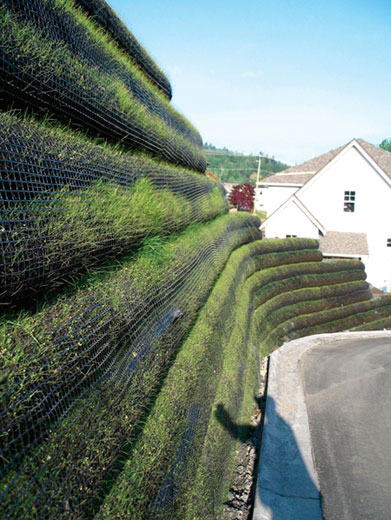
Compost based BMPs used in wall systems allow a customization of
vegetation including seed, sprigs, plugs, and live stakes for a truly green
wall. Photo credit: Denbow Transport, Vancouver, BC.
The Texas Department of Transportation slope stabilization efforts are a case in point. TxDOT contractors receive final payment for roadway stabilization projects once vegetation covers 70 percent of the disturbed site. Contractors that used standard hydroseeding needed a number of site visits before that coverage was achieved, costing them money and delayed payment for the work performed. In May 1999, TxDOT and the Texas Natural Resources Conservation Commission (now Texas Commission on Environmental Quality), worked jointly to demonstrate the application of compost along roadsides to the public, potential contractors and other interested parties. The demonstration was held in the West Texas town of Big Spring at a site where TxDOT had tried five times — unsuccessfully — to establish vegetation on a steep, severely eroded overpass. There were 6-inch gullies running the entire length of the slope. Compost made from feedlot manure, cotton burrs and yard trimmings wood chips was applied with a blower truck at a depth of 3-inches, and was used to fill the gullies. Grass seed was mixed in with the compost prior to application. By mid-June 1999, thick grass was growing on soil that was barren since the highway was constructed over 30 years before. Compost was the only application that provided a successful growing media over that time.
After the successful Big Spring project, the two state agencies initiated many more demonstrations. A number of them were for TxDOT districts, and had similar results. The demonstrations also provided an opportunity to test compost classifications that eventually were used for TxDOT's compost and mulch specifications. Compost blankets have become the standard practice for slope stabilization. Over the past five years well over a million cubic yards of compost have been used in TxDOT projects for blankets and filter berms, and a variety of applications using filter socks.
Compost made from leaves, grass and brush ("yard waste") is the most common source of material used in storm water and sediment and erosion control projects. Other feedstocks include livestock manure (e.g., dairy manure compost in Texas), municipal wastewater biosolids, and source separated food waste streams. According to BioCycle magazine's State of Garbage in America survey (2006), there are close to 3,500 yard waste composting projects in the United States.
Product quality and consistency are keys to successfully using compost for water and soil quality projects. Parameters evaluated include biological stability of the compost, (i.e., respiration rate), particle size and amount of contaminants such as plastic. Compost use specifications adopted by the American Association of State Highway Transportation Officials (AASHTO) as well as numerous state Departments of Transportation incorporate these parameters.
An early adopter of compost use for erosion and sediment control and storm water management was Filtrexx International, LLC, based in Grafton, Ohio. Today, the company has nearly 100 certified installers in the U.S. and Canada, as well as Japan, New Zealand, Australia, Holland and other countries in the UK. The connection between particle size of the compost and BMP performance was recognized early on by Filtrexx. The key is to have the particle size small enough to trap sediment, but large enough to allow water to flow through. The company's design specifications (www.filtrexx.com/specifications) identify the particle sizes needed to achieve both retention and flow through. This process is similar to a made to order production process more than it is a by product operation.
Compost stability is especially important when the BMP requires establishing vegetation, e.g., a seeded compost blanket or filter berm. Compost that is still in the active stage of decomposition will deprive the plant of proper nutrient uptake. So for seeded applications, attention to stability and nutrient balance is key. However, for filtering applications, these properties are not as important unless it involves plants.
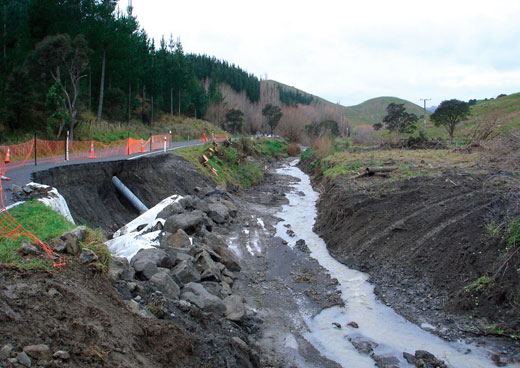
Restoration of eroded creekbanks are challenging because vegetation is hard to establish.
Using compost based BMPs allows faster establishment (see photo page 52). Photo credit:
RST Environmental Solutions, New Zealand.
In addition to surface water infiltration and filtration, additional benefits related to compost-based BMPs include: 1) Trapping and removal of soluble pollutants in storm water such as hydrocarbons, nitrate-N and phosphorus; 2) Direct soil-to BMP contact by filling in rills on slopes (e.g., with a blanket), and greater surface area contact with soil or pavement than typical sediment control devices, reducing potential for runoff to undercut the BMP and allow unfiltered sediment to flow through; 3) Multi-dimensional design (versus one dimension of BMP like silt fence) whereby longer contact time for the 'filter' to act is allowed; 4). Bio-remediation properties for materials left in the compost media after water passes, like hydrocarbons that break down from biological activity and turn into CO2 and water.
Maximizing BMP Performance
Research conducted by Portland (OR) Metro and W&H Pacific (Stewart et al., 1993) in the early 1990s provided valuable data on the performance of compost filter berms as compared to silt fence and bare soil. In one test, total suspended solids (for five storm period) was about 500 mg/L for a yard waste compost berm compared to >6,000 mg/L for a silt fence. These research findings have been replicated in other studies over the past decade including University of Georgia, The Ohio State University, Iowa State University, and USDA. A total of 13 universities have conducted impressive research about the impact compost has on the environment where it is used. It is 'all good'.
While the performance capabilities of filter berms was proven, the ability to use them in a variety of applications, e.g., where there was a higher water flow, or around active construction sites where they could be flattened or cleared away, was limited. Filtrexx International addressed this challenge by designing, and subsequently patenting, the SiltSoxx™ three-dimensional tubular sediment control and storm water runoff filtration device typically used for perimeter control of sediment and soluble pollutants. This containment system broadened the applicability of compost-based BMPs, not only for perimeter control, but for inlet protection, ditch checks, slope interruption, runoff diversion and stream bank restoration. In some projects, the sock system is stacked and planted with live stakes, creating a living wall.
As the applications broadened, so did the dimensions of filter socks. For example, a standard perimeter control application may use a 12" sock while a living wall application at 1:1 slope might use an 18" diameter product. Key to determining the dimension is a calculation of maximum performance for the lowest cost/linear foot. In many applications, the 8, 12,18, or 24 -inch sock is used instead of any type of silt fence at a lower cost. Some states are allowing substitution of these tools on any project.
Like any BMP used for erosion and sediment control and storm water management, maintenance will be necessary to ensure long-term performance. For example,
sediment may build up behind the filter sock or berm, eventually pushing storm water flows over the top of the BMP instead of through it. Periodic maintenance
includes removing that built up sediment or fixing any breached areas. The total cost should be calculated by adding 1) Installation; 2) Maintenance; 3) Repair;
4) Removal; and 5) Disposal. Those five costs add up to be the 'Life Cycle Costs' of that particular BMP. For a study identifying these costs and how they relate
to each product used, go to:
http://www.epa.gov/epaoswer/non-hw/green/tools/index.htm
Look for Erosion Control Calculator.
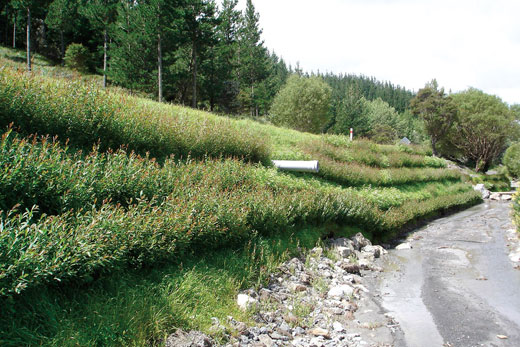
Integrating live stakes of willows or other native vegetation with compost based BMPs
allows for protection while staying green. Photo credit: RST Environmental Solutions, New
Zealand.
Industry Acceptance
Performance of compost-based BMPs and amended soils at construction and post-construction installations has accelerated their acceptance within the construction and landscape industries. However, this acceptance did not happen overnight. It has taken many years of outreach and education — including field trials, monitoring of installations and ongoing research — to local soil and water conservation districts, state storm water regulators, Departments of Transportation, landscape architects, construction contractors and land developers to explain the concept of living systems and working with site soils.
As local and regional governments are faced with TMDL compliance, BMP performance becomes ever more critical. Compost-based BMPs that mimic nature by restoring
soil performance in terms of infiltration and filtration are competitive price-wise with standard BMPs. The fact that compost is made from locally renewable resources
such as yard trimmings and other organic waste streams is an added benefit. Nothing can match the sustainable option of using these products when combined with the
natural environmental benefits. Nothing closer resembles the natural system that was here before we moved the first foot of dirt for construction. ![]()
For more information, contact Rod Tyler, Filtrexx International LLC (440)926-8041 or e-mail: rodt@filtrexx.com.

